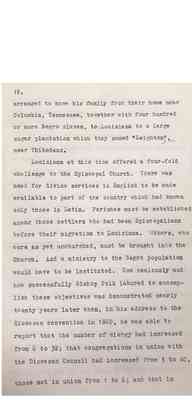Pages That Mention slaves
Polk Family Papers Box 1 Document
19
-18-
arranged to move his family from their home near Columbia, Tennessee, together with four hundred or more Negro slaves, to Louisiana to a large sugar plantation which they named "Leighton," near Thibodaux.
Louisiana at this time offered a four-fold challenge to the Episcopal Church. There was need for divine services in English to be made available in part of the country which had known only those in Latin. Parishes must be established among those settlers who had been Episcopalians before their migration to Louisiana. Others, who were as yet unchurched, must be brought into the Church. And a ministry to the Negro population would have to be instituted. How zealously and how successfully Bishop Polk labored to accomplish these objectives was demonstrated nearly twenty years later when, in his address to the diocesan convention in 1860, he was able to report that the number of clergy had increased from 6 to 32; that congregations in union with the Diocesan Council had increased from 3 to 40, those not in union from 1 to 6; and that in
20
-19-
addition 30 or more congregations of slaves had been organized to have the Gospel preached to them.
Of Bishop Polk's pastoral and episcopal character the following account has been furnished by the Reverend John Fulton, who was brought to the Bishop's home in May, 1857, to be examined for Holy Orders: "Presently we heard a quick, firm step in the hall, and the bishop entered. One glance revealed the man; his first address, the gentleman; his penetrating, sympathetic look, the friend and father. He was then over fifty years of age, but his clear complexion, his keen bright eye, and his elastic step made him appear not more than forty-six or forty-eight. Standing over six feet in height, his form was cast in the ideal mold of a soldier. His broad shoulders, his lean flank, his erect carriage, and his decidedly military bearing prepared one for the clear, distinct voice, which never struck one as imperious, but always had a certain tone of command. It was a voice to make itself heard amid the din of battle, and yet by the bedside of the sick and
23
-22-
with the weak, his skill in administering a needed rebuke.
In the years from 1848 to 1854 came a succession of disasters which destroyed the Bishop's personal estate. The first to strike was cholera: the Bishop himself sickened of it, and on "Leighton" 100 slaves died of it. In 1850 a tornado struck and destroyed the sugar house, stables and cabins of the slaves. An early frost cut the sugar crop to a third of normal. The next year the Bishop's misplaced trust in a Tennessee friend ended in the loss of a large sum of money. During 1853 two of his own children died by yellow fever, and again the epidemic carried off a large number of his slaves. By the spring of 1854 he realized his debts had grown to the point where he would have to turn the plantation over to his creditors, and, to provide temporarily for his family, he would have to take the rectorship of a parish church. And yet it was precisely during these years that he was industriously planning his great project of a university for the Southern states that would rival the establishment at Harvard or Yale. Where,


